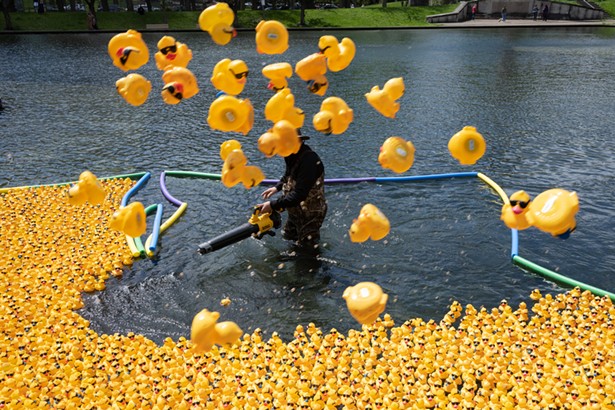Zero insight is needed to see Steven Spielberg's remake of War of the Worlds as commentary on our terrorist-haunted, globally insecure times. Indeed, Spielberg's alien-invasion scenario so bluntly appropriates the au courant iconography of disaster -- smashed airplanes, ash-coated survivors, walls of handmade "missing" posters -- that it's fair to call it shameless.
But if outer-space evildoers aren't terrorist hijackers, neither must stories be real to be true. And Spielberg's richly layered vision, nicely complicated with a cunning twist, might be the most interesting post-9/11 drama yet in a summer peppered with them.
While War of the Worlds is outfitted as an action film, it's structured, in Spielbergian fashion, as a domestic drama. The hero is Ray Ferrier (Tom Cruise), a cocky East Coast dockworker whose ex-wife has just deposited their sullen teen-age son and anxious 10-year-old daughter with him for a few days. Robbie (Justin Chatwin) and Rachel (Dakota Fanning) dislike Ray; the camera tracks them all restlessly through Ray's house, etching a brief but incisive portrait of familial anomie before the sky cracks open and 80-story outer-space death machines send everyone fleeing for their lives.
The bulk of the movie is one long flight. Ray wants to get the kids to their mother, in Boston. But aliens are smashing everything and killing everybody, and hordes of fellow refugees clog the trail. On this level alone, War of the Worlds is an above-average night at the movies, largely because Spielberg's craft is elevated to near-stunning levels.
Early scenes have a strikingly "off" look, the camera held low and shaky (a frightened child's point of view), the colors subdued, the partially backlit subjects sometimes near-silhouettes. There's poetically suggestive imagery -- a church façade splits from its building, light pouring through stained glass; a train ablaze careens through a railroad crossing. An extended sequence, with Ray and Rachel hiding in the decrepit cellar of a lone man (Tim Robbins) who proves mentally unstable, is remarkable for its beautiful low-light shooting and deft editing. The alien vessels, called Tripods, are like nightmare arachnids, while the invaders themselves highlight the sequence with their first appearance. They're long-limbed reptilian bipeds with a certain curiosity that makes us at least wonder about their "humanity."
While Spielberg's camera hardly ever stops moving, it's never flash for flash's sake: It probes space as sinuously, as thoroughly, as one of the aliens' camera-eyed surveillance tentacles. But that's apt in a movie that's largely about seeing. Ray starts out encouraging Rachel to gape at the bizarre storm that, unbeknownst to everyone, heralds the invasion. But when destruction descends, he's intent on shutting her eyes, even blindfolding her at one point. There's also running commentary on the mediation of war: Our first sight of a human vaporized by an alien ray is through the screen of a video camera someone's dropped, and Ray's exodus includes an encounter with a cynical TV news crew that apprises him of the global scope of the destruction -- and of the informational black holes attack sites become.
The film's most provocative touch, however, might be a nifty paradigm shift in the script, written by Josh Friedman and David Koepp. Ray starts the film literally on top of the world -- moving cargo from high in the cab of a dockside crane that eerily foreshadows the Tripods themselves. Under attack, Ray and his fellow ground-bound humans initially echo nothing but 9/11 survivors. But eventually they're transformed from First Worlders victimized in a devastating sneak attack to the dispossessed denizens of an occupied land, at the mercy of heavily armed invaders intent on exploiting their natural resources (in this case, the occupied populace's own bodies, processed for fertilizer).
War of the Worlds suffers its share of plot illogic and, ultimately, domestic sentimentality (though there's much less of the latter than Spielberg usually spiels our way). Occasionally Cruise, attempting to charm, looks too relaxed for a man navigating a cataclysm. And like M. Night Shyamalan's Signs, War of the Worlds risks turning into history's most lethal parent-counseling session, with deaths by the millions the price of happiness for one man's troubled family. But unlike Signs, here the restoration of family finally seems a happy accident -- a fallout of the disaster, not its cause or the cause of its ultimate conclusion.
More importantly, though, Spielberg takes the smart anticlimax of H.G. Wells' source novel -- unstoppable aliens undone by the merest of Earthly microbes -- and imbues it with a layer of political allegory. This summer I've so far seen two other blockbusters with war on terror/Iraqi war subtexts. But unlike Batman Begins and Star Wars Episode III, War of the Worlds doesn't ask where evil comes from, or even what it is. Rather, it looks beyond, to a place where violence in one's own defense might be necessary, but hardly sufficient. Read between the lines: Spielberg's dare-we-say "liberal" vision is a hopeful, democratic one in which malign seeds can't grow in good soil, and the lungs of conquerors can't breathe free air. 














